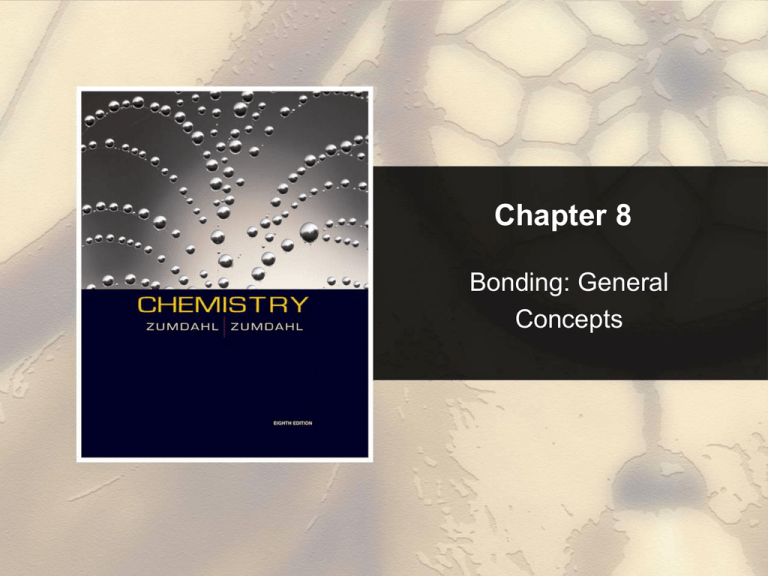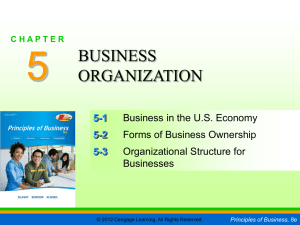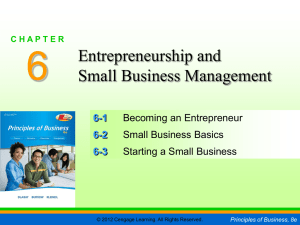
Chapter 8
Bonding: General
Concepts
Chapter 8
Table of Contents
8.1
8.3
8.5
8.6
8.7
8.8
8.9
8.10
8.11
8.12
8.13
Types of Chemical Bonds
Bond Polarity and Dipole Moments
Energy Effects in Binary Ionic Compounds
Partial Ionic Character of Covalent Bonds
The Covalent Chemical Bond: A Model
Covalent Bond Energies and Chemical Reactions
The Localized Electron Bonding Model
Lewis Structures
Exceptions to the Octet Rule
Resonance
Molecular Structure: The VSEPR Model
Section 8.1
Types of Chemical Bonds
A Chemical Bond
• No simple, and yet complete, way to define this.
• Forces that hold groups of atoms together and
make them function as a unit.
• A bond will form if the energy of the aggregate is
lower than that of the separated atoms.
Return to TOC
Copyright © Cengage Learning. All rights reserved
3
Section 8.1
Types of Chemical Bonds
The Interaction of
Two Hydrogen
Atoms
Return to TOC
Copyright © Cengage Learning. All rights reserved
4
Section 8.1
Types of Chemical Bonds
Key Ideas in Bonding
• Ionic Bonding – electrons are transferred
• Covalent Bonding – electrons are shared equally
• What about intermediate cases?
Return to TOC
Copyright © Cengage Learning. All rights reserved
5
Section 8.1
Types of Chemical Bonds
Polar Covalent Bond
• Unequal sharing of electrons between atoms in
a molecule.
• Results in a charge separation in the bond
(partial positive and partial negative charge).
Return to TOC
Copyright © Cengage Learning. All rights reserved
6
Section 8.1
Types of Chemical Bonds
Polar Molecules
Return to TOC
Copyright © Cengage Learning. All rights reserved
7
Section 8.2
Electronegativity
The Pauling Electronegativity Values
Return to TOC
Copyright © Cengage Learning. All rights reserved
8
Section 8.2
Electronegativity
The Relationship Between Electronegativity and Bond Type
Return to TOC
Copyright © Cengage Learning. All rights reserved
9
Section 8.2
Electronegativity
Exercise
Arrange the following bonds from most to least
polar:
a)
N–F
a) C–F,
b)C–F
b) Si–F,
c) Cl–Cl
c)
B–Cl,
Copyright © Cengage Learning. All rights reserved
O–F
N–F,
N–O
C–F,
B–Cl
C–F
O–F
Si–F
N–O
S–Cl
S–Cl,
Cl–Cl
Return to TOC
10
Section 8.3
Bond Polarity and Dipole Moments
Dipole Moment
• Property of a molecule whose charge
distribution can be represented by a center of
positive charge and a center of negative charge.
• Use an arrow to represent a dipole moment.
Point to the negative charge center with the
tail of the arrow indicating the positive center
of charge.
Return to TOC
Copyright © Cengage Learning. All rights reserved
11
Section 8.3
Bond Polarity and Dipole Moments
Dipole Moment
Return to TOC
Copyright © Cengage Learning. All rights reserved
12
Section 8.3
Bond Polarity and Dipole Moments
No Net Dipole Moment (Dipoles Cancel)
Return to TOC
Copyright © Cengage Learning. All rights reserved
13
Which of the following molecules have a dipole moment?
H2O, CO2, SO2, and CH4
O
S
dipole moment
polar molecule
dipole moment
polar molecule
H
O
C
O
no dipole moment
nonpolar molecule
H
C
H
H
no dipole moment
nonpolar molecule
10.2
Section 8.4
Ions: Electron Configurations and Sizes
Electron Configurations in Stable Compounds
• Two nonmetals form a covalent bond by sharing
electrons to complete the valence electron
configurations of both atoms.
• A metal and a nonmetal form ions by emptying
the valence orbitals of the metal and adding
electrons to the nonmetal to gain a noble gas
configuration. These ions then form a binary
ionic compound.
Return to TOC
Copyright © Cengage Learning. All rights reserved
15
Section 8.5
Energy Effects in Binary Ionic Compounds
Lattice Energy
• The change in energy that takes place when
separated gaseous ions are packed together to
form an ionic solid.
Q1Q2
Lattice energy = k
r
k = proportionality constant
Q1 and Q2 = charges on the ions ** affects size
r = shortest distance between the centers of the
cations and anions
Copyright © Cengage Learning. All rights reserved
Return to TOC
16
Section 8.5
Energy Effects in Binary Ionic Compounds
Born-Haber Cycle for NaCl
Return to TOC
Copyright © Cengage Learning. All rights reserved
17
Section 8.5
Energy Effects in Binary Ionic Compounds
Formation of an Ionic Solid
Lattice Energy problems must always be done for a single
atom in the gas state – and be sure to know the SIGN of each
1. Convert to gas phase if needed (for solids…
Sublimation of the solid metal.)
• M(s) M(g) [endothermic (+)]
2. Ionization Energy of the metal atoms. (may need
to add 1st IE, 2nd IE, etc.)
• M(g) M+(g) + e [endothermic (+)]
3. Dissociation of the nonmetal if needed.
• 1/2X2(g) X(g) [endothermic (+)]
Return to TOC
Copyright © Cengage Learning. All rights reserved
18
Section 8.5
Energy Effects in Binary Ionic Compounds
Formation of an Ionic Solid (continued)
4. Electron Affinity for Formation of X ions in the
gas phase.
• X(g) + e X(g) [exothermic (-)]
5. Lattice Energy for Formation of the solid MX.
• M+(g) + X(g) MX(s)
[quite exothermic (-)]
Return to TOC
Copyright © Cengage Learning. All rights reserved
19
Born-Haber Cycle for Determining Lattice Energy
o
DHoverall
= DHo1 + DHo2 + DHo3 + DHo4 + DHo5
9.3
Section 8.5
Energy Effects in Binary Ionic Compounds
Comparing
Energy Changes
Return to TOC
Copyright © Cengage Learning. All rights reserved
21
Section 8.8
Covalent Bond Energies and Chemical Reactions
Bond Energies
• To break bonds, energy must be added to the
system (endothermic).
• To form bonds, energy is released (exothermic).
Return to TOC
Copyright © Cengage Learning. All rights reserved
22
Section 8.8
Covalent Bond Energies and Chemical Reactions
Bond Energies
DH = n×D(bonds broken) – n×D(bonds formed)
D represents the bond energy per mole of
bonds (always has a positive sign).
Return to TOC
Copyright © Cengage Learning. All rights reserved
23
Average Bond Energies
Copyright © Cengage Learning. All rights reserved.
8 | 24
The enthalpy change required to break a particular bond in
one mole of gaseous molecules is the bond energy.
Bond Energy
DH0 = 432 kJ
H2 (g)
H (g) + H (g)
Cl2 (g)
Cl (g) + Cl (g) DH0 = 239 kJ
HCl (g)
H (g) + Cl (g) DH0 = 427 kJ
O2 (g)
O (g) + O (g) DH0 = 495 kJ
O
O
N2 (g)
N (g) + N (g) DH0 = 943 kJ
N
N
Bond Energies
Single bond < Double bond < Triple bond
9.10
Bond Lengths for Selected Bonds
Copyright © Cengage Learning. All rights reserved.
8 | 26
H2 (g) + Cl2 (g)
2HCl (g)
2H2 (g) + O2 (g)
2H2O (g)
9.10
Use bond energies to calculate the enthalpy change for:
H2 (g) + F2 (g)
2HF (g)
DH0 = BE(reactants) – BE(products)
Type of
bonds broken
H
H
F
F
Type of
bonds formed
H
F
Number of
bonds broken
Bond energy
(kJ/mol)
Energy
change (kJ)
1
1
432
154
432
154
Number of
bonds formed
Bond energy
(kJ/mol)
Energy
change (kJ)
2
565
1130
DH0 = 432 + 154 – (2 x 565) = -544 kJ
9.10
Section 8.8
Covalent Bond Energies and Chemical Reactions
Exercise
Predict DH for the following reaction:
CH3N C(g ) CH3C N( g )
Given the following information:
Bond Energy (kJ/mol)
C–H
413
C–N
305
C–C
347
CN
891
DH = –42 kJ
Copyright © Cengage Learning. All rights reserved
Return to TOC
29
Section 8.7
The Covalent Chemical Bond: A Model
Models
• Models are attempts to explain how nature
operates on the microscopic level based on
experiences in the macroscopic world.
Return to TOC
Copyright © Cengage Learning. All rights reserved
30
Section 8.7
The Covalent Chemical Bond: A Model
Fundamental Properties of Models
1. A model does not equal reality.
2. Models are oversimplifications, and are
therefore often wrong.
3. Models become more complicated and are
modified as they age.
4. We must understand the underlying
assumptions in a model so that we don’t misuse
it.
5. When a model is wrong, we often learn much
more than when it is right.
Return to TOC
Copyright © Cengage Learning. All rights reserved
31
Section 8.9
The Localized Electron Bonding Model
Localized Electron Model
• A molecule is composed of atoms that are
bound together by sharing pairs of electrons
using the atomic orbitals of the bound atoms.
Return to TOC
Copyright © Cengage Learning. All rights reserved
32
Section 8.9
The Localized Electron Bonding Model
Localized Electron Model
• Electron pairs are assumed to be localized on a
particular atom or in the space between two
atoms:
Lone pairs – pairs of electrons localized on
an atom
Bonding pairs – pairs of electrons found in
the space between the atoms
Return to TOC
Copyright © Cengage Learning. All rights reserved
33
Section 8.9
The Localized Electron Bonding Model
Localized Electron Model
1. Description of valence electron arrangement
(Lewis structure).
2. Prediction of geometry (VSEPR model).
3. Description of atomic orbital types used to
share electrons or hold lone pairs.
Return to TOC
Copyright © Cengage Learning. All rights reserved
34
Section 8.10
Lewis Structures
Lewis Structure
• Shows how valence electrons are arranged
among atoms in a molecule.
• Reflects central idea that stability of a compound
relates to noble gas electron configuration.
Return to TOC
Copyright © Cengage Learning. All rights reserved
35
Section 8.10
Lewis Structures
Duet Rule
• Hydrogen forms stable molecules where it shares two
electrons.
Return to TOC
Copyright © Cengage Learning. All rights reserved
36
Section 8.10
Lewis Structures
Octet Rule
• Elements form stable molecules when
surrounded by eight electrons.
Return to TOC
Copyright © Cengage Learning. All rights reserved
37
Section 8.10
Lewis Structures
Steps for Writing Lewis Structures
1. Sum the valence electrons from all the atoms.
2. Use a pair of electrons to form a bond between
each pair of bound atoms.
3. Atoms usually have noble gas configurations.
Arrange the remaining electrons to satisfy the
octet rule (or duet rule for hydrogen).
Return to TOC
Copyright © Cengage Learning. All rights reserved
38
Section 8.10
Lewis Structures
Steps for Writing Lewis Structures
1. Sum the valence electrons from all the atoms.
(Use the periodic table.)
Example: H2O
2 (1 e–) + 6 e– = 8 e– total
Return to TOC
Copyright © Cengage Learning. All rights reserved
39
Section 8.10
Lewis Structures
Steps for Writing Lewis Structures
2. Use a pair of electrons to form a bond between
each pair of bound atoms.
Example: H2O
H O H
Return to TOC
Copyright © Cengage Learning. All rights reserved
40
Section 8.10
Lewis Structures
Steps for Writing Lewis Structures
3. Atoms usually have noble gas configurations.
Arrange the remaining electrons to satisfy the
octet rule (or duet rule for hydrogen).
Examples: H2O, PBr3, and HCN
Br
H O H
Br
P Br
H C N
Return to TOC
Copyright © Cengage Learning. All rights reserved
41
Section 8.10
Lewis Structures
Concept Check
Draw a Lewis structure for each of the
following molecules:
NH3
CO2
CCl4
Return to TOC
Copyright © Cengage Learning. All rights reserved
42
Section 8.11
Exceptions to the Octet Rule
• Boron tends to form compounds in which the
boron atom has fewer than eight electrons
around it (it does not have a complete octet).
BH3 = 6e–
H
H B H
Return to TOC
Copyright © Cengage Learning. All rights reserved
43
Section 8.11
Exceptions to the Octet Rule
• When it is necessary to exceed the octet rule for
one of several third-row (or higher) elements,
place the extra electrons on the central atom.
SF4 = 34e–
AsBr5 = 40e–
F
F S
F
F
Br Br
Br As Br
Br
Return to TOC
Copyright © Cengage Learning. All rights reserved
44
Violations of the Octet Rule
Usually occurs with B and elements of higher periods and
most nonmetals. Common exceptions are: Be, B, P, S, Xe,
Cl, Br, and As.
How do you know if it’s an EXPANDED octet?
– More valence electrons than the initial drawing
– More than 4 bonds
– Formal Charge doesn’t work out
with just 8
Expanded
Incomplete
Be: 4
BF3 B: 6
P: 8 OR 10
S: 8, 10, OR 12
Xe: 8, 10, OR 12
SF4
Section 8.11
Exceptions to the Octet Rule
Concept Check
Draw a Lewis structure for each of the
following molecules:
BF3
PCl5
SF6
Return to TOC
Copyright © Cengage Learning. All rights reserved
46
Section 8.11
Exceptions to the Octet Rule
Let’s Review
• C, N, O, and F should always be assumed to
obey the octet rule.
• B and Be often have fewer than 8 electrons
around them in their compounds.
• Second-row elements never exceed the octet
rule.
• Third-row and heavier elements often satisfy the
octet rule but can exceed the octet rule by using
their empty valence d orbitals.
Return to TOC
Copyright © Cengage Learning. All rights reserved
47
Section 8.11
Exceptions to the Octet Rule
Let’s Review
• When writing the Lewis structure for a molecule,
satisfy the octet rule for the atoms first. If
electrons remain after the octet rule has been
satisfied, then place them on the elements
having available d orbitals (elements in Period 3
or beyond).
Return to TOC
Copyright © Cengage Learning. All rights reserved
48
Section 8.12
Resonance
• More than one valid Lewis structure can be
written for a particular molecule.
NO3– = 24e–
O
O
N
O
O
O
O
N
O
O
N
O
Return to TOC
Copyright © Cengage Learning. All rights reserved
49
Section 8.12
Resonance
• Actual structure is an average of the resonance
structures.
• Electrons are really delocalized – they can move
around the entire molecule. ATOMS do not
move!
O
O
N
O
O
O
O
N
O
O
N
O
Return to TOC
Copyright © Cengage Learning. All rights reserved
50
Section 8.12
Resonance
Concept Check
Draw a Lewis structure for each of the
following molecules:
CO
CH3OH
CO2
OCN–
Return to TOC
Copyright © Cengage Learning. All rights reserved
51
Section 8.12
Resonance
Formal Charge
• Used to evaluate nonequivalent Lewis
structures.
• Atoms in molecules try to achieve formal
charges as close to zero as possible.
• Any negative formal charges are expected to
reside on the most electronegative atoms.
formal charge
on an atom in a =
Lewis structure
total number of
valence
electrons in the
free atom
-
total number of
nonbonding
electrons
-
1
2
(
total number of
bonding
electrons
)
Return to TOC
Copyright © Cengage Learning. All rights reserved
52
Section 8.12
Resonance
Concept Check
Consider the Lewis structure for POCl3.
Assign the formal charge for each atom in the
molecule.
Cl
P: 5 – 0 – ½ (8) = +1
O: 6 – 6 – ½ (2) = –1
Cl: 7 – 6 – ½ (2) = 0
Cl P O
Cl
Return to TOC
Copyright © Cengage Learning. All rights reserved
53
Section 8.12
Resonance
Rules Governing Formal Charge
• The sum of the formal charges of all atoms in a
given molecule or ion must equal the overall
charge on that species.
Return to TOC
Copyright © Cengage Learning. All rights reserved
54
Section 8.12
Resonance
Rules Governing Formal Charge
• If nonequivalent Lewis structures exist for a
species, those with formal charges closest to
zero and with any negative formal charges on
the most electronegative atoms are considered
to best describe the bonding in the molecule or
ion.
O C O
O C O
Return to TOC
Copyright © Cengage Learning. All rights reserved
55
Section 8.12
Resonance
Concept Check
• Draw the best structure for the anion: thiocyanate.
Return to TOC
Copyright © Cengage Learning. All rights reserved
56
Section 8.13
Molecular Structure: The VSEPR Model
VSEPR Model
• VSEPR: Valence Shell Electron-Pair Repulsion.
• The structure around a given atom is determined
principally by minimizing electron pair
repulsions.
Return to TOC
Copyright © Cengage Learning. All rights reserved
57
Section 8.13
Molecular Structure: The VSEPR Model
Steps to Apply the VSEPR Model
1. Draw the Lewis structure for the molecule.
2. Count the electron pairs and arrange them in
the way that minimizes repulsion (put the pairs
as far apart as possible.
3. Determine the positions of the atoms from the
way electron pairs are shared (how electrons
are shared between the central atom and
surrounding atoms).
4. Determine the name of the molecular structure
from positions of the atoms.
Return to TOC
Copyright © Cengage Learning. All rights reserved
58
Section 8.13
Molecular Structure: The VSEPR Model
VSEPR
Return to TOC
Copyright © Cengage Learning. All rights reserved
59
Section 8.13
Molecular Structure: The VSEPR Model
VSEPR: Two Electron Pairs
Return to TOC
Copyright © Cengage Learning. All rights reserved
60
Section 8.13
Molecular Structure: The VSEPR Model
VSEPR: Three Electron Pairs
Return to TOC
Copyright © Cengage Learning. All rights reserved
61
Section 8.13
Molecular Structure: The VSEPR Model
VSEPR: Four Electron Pairs
Return to TOC
Copyright © Cengage Learning. All rights reserved
62
Section 8.13
Molecular Structure: The VSEPR Model
VSEPR: Iodine Pentafluoride
Return to TOC
Copyright © Cengage Learning. All rights reserved
63
Section 8.13
Molecular Structure: The VSEPR Model
Arrangements of Electron Pairs Around an Atom Yielding
Minimum Repulsion
Return to TOC
Copyright © Cengage Learning. All rights reserved
64
Section 8.13
Molecular Structure: The VSEPR Model
Arrangements of Electron Pairs Around an Atom Yielding
Minimum Repulsion
Return to TOC
Copyright © Cengage Learning. All rights reserved
65
Section 8.13
Molecular Structure: The VSEPR Model
Structures of Molecules That
Have Four Electron Pairs
Around the Central Atom
Return to TOC
Copyright © Cengage Learning. All rights reserved
66
Section 8.13
Molecular Structure: The VSEPR Model
Structures of Molecules
with Five Electron Pairs
Around the Central Atom
Return to TOC
Copyright © Cengage Learning. All rights reserved
67
Valence shell electron pair
repulsion (VSEPR) model:
Predict the geometry of the
molecule from the electrostatic
repulsions between the electron
(bonding and nonbonding) pairs.
This chart is
NOT provided
on the AP exam!
Section 8.13
Molecular Structure: The VSEPR Model
Concept Check
Determine the shape for each of the following
molecules, and include bond angles:
HCN
PH3
SF4
HCN – linear, 180o
PH3 – trigonal pyramid, 109.5o (107o)
SF4 – see saw, 90o, 120o
Copyright © Cengage Learning. All rights reserved
Return to TOC
69
Section 8.13
Molecular Structure: The VSEPR Model
Concept Check
Determine the shape for each of the following
molecules, and include bond angles:
O3
KrF4
O3 – bent, 120o
KrF4 – square planar, 90o, 180o
Return to TOC
Copyright © Cengage Learning. All rights reserved
70







